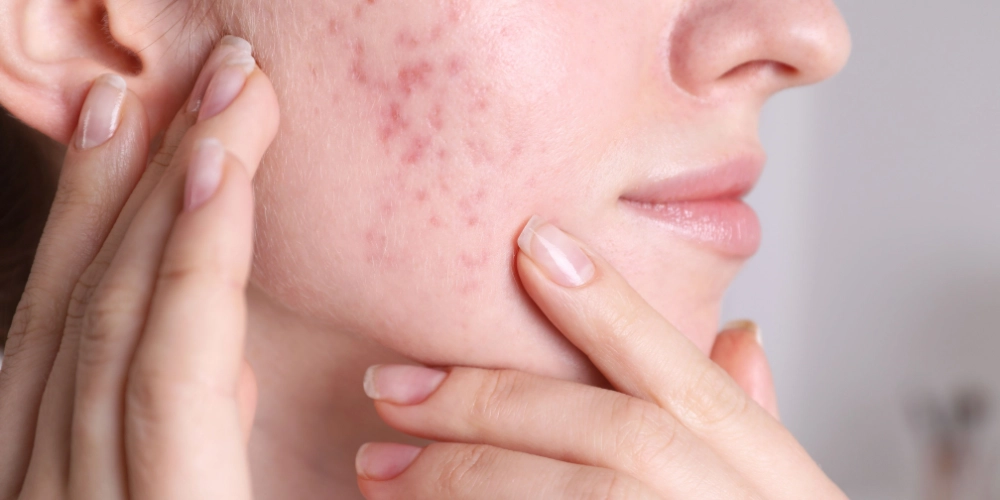Why Do Whiteheads Form? Science-Backed Answers and Prevention Tips
Understanding Whiteheads: The Basics
Whiteheads are small, pale bumps that appear on the skin when pores get clogged with oil, bacteria, and dead skin cells.
Anúncios
These closed pores become inflamed, forming whiteheads.
As part of the comedonal family, whiteheads differ from blackheads primarily due to the state of the pore.
If the pore is closed, a whitehead forms, while an open pore results in a blackhead, which appears darker due to exposure to air.
Anúncios
The Comedonal Family
Whiteheads and blackheads are both comedonal forms of acne.
Recognizing the distinction between these two types is essential for understanding how to treat and manage them.
Blackheads occur when a pore remains open and the material inside oxidizes, turning a dark color.
Anúncios
On the other hand, the contents of a whitehead remain trapped beneath the skin, leading to its lighter appearance.
Prevalence and Impact
Acne, including whiteheads, is the most common skin condition in the United States, affecting over 50 million Americans each year.
It’s a widespread issue that can affect anyone, regardless of age or gender.
Notably, nearly 90% of individuals experience acne at some point in their lives.
This prevalence suggests that acne, including whiteheads, is not just a cosmetic concern but a common and sometimes persistent skin condition that requires understanding and effective management.
Though grappling with whiteheads can be frustrating, it’s important to remember that you are not alone.
Next, we’ll explore the primary causes of whitehead formation, providing insight into the factors contributing to this common skin condition.
 It’s a common problem in the US
It’s a common problem in the US
Primary Causes of Whitehead Formation
Whiteheads can be frustrating, but understanding the primary causes behind them can help in managing and preventing these pesky blemishes.
Let’s delve into the key factors that contribute to whitehead formation.
Genetic Predisposition
Genetic factors play a significant role in the development of whiteheads.
If your parents had acne, there’s a higher likelihood that you might experience it as well.
This genetic predisposition determines how your skin behaves, including its oil production and how your pores respond to clogging.
Essentially, your genetics set the stage for your skin type, which can influence your susceptibility to whiteheads.
Hormonal Influences
Hormones are another major player in the formation of whiteheads.
During puberty, hormone levels, particularly androgens, increase and stimulate the sebaceous glands to produce more oil.
This excess oil can clog pores, leading to whiteheads.
Hormonal fluctuations during menstrual cycles, pregnancy, and even stress can also trigger whitehead formation.
Adults aren’t immune either—hormonal changes continue to affect the skin well beyond teenage years.
Excess Oil Production and Clogged Pores
The production of excess oil, or sebum, is directly linked to the formation of whiteheads.
Sebum is essential for keeping our skin hydrated, but too much of it can cause problems.
When excess oil mixes with dead skin cells and bacteria, it can clog pores
. Unlike blackheads, where the pore remains open, whiteheads form when the clogged pore closes up, trapping the debris inside.
This results in the characteristic small, white bump.
Knowing that genetics, hormones, and excess oil are core contributors to whitehead formation arms us with valuable information for tackling them.
With this foundational understanding, we can explore how lifestyle factors and targeted treatments can help manage and prevent whiteheads.
Lifestyle Factors That Worsen Whiteheads
Impact of Stress and Inadequate Sleep on Skin Health
When it comes to whiteheads, stress and lack of sleep can play significant roles.
Life’s pressures can cause the body to produce more cortisol, often referred to as the stress hormone.
Elevated cortisol levels can lead to increased oil production in the skin, which, as we know, is a primary factor in whitehead formation.
Couple stress with inadequate sleep, and you have a recipe for skin issues.
The body repairs itself during sleep, including skin repair.
Interrupted or insufficient sleep disrupts this process, leading to less time for skin to recover, making it more prone to breakouts and whiteheads.
Connection Between Diet and Acne Formation
You are what you eat, and this couldn’t be truer for your skin.
Certain foods can influence hormonal balance and oil production, thus exacerbating whiteheads.
For instance, high glycemic index foods (like white bread, sugary snacks, and soda) can spike blood sugar levels, leading to an increase in insulin.
This surge in insulin can provoke the production of excess oil, clogging pores and leading to whiteheads.
Moreover, dairy products have been linked to higher incidences of acne.
Monitoring and potentially adjusting one’s diet can help manage and reduce the formation of whiteheads.
Effects of Smoking on Whitehead Development, Especially in Women
Smoking carries a myriad of health risks, but its impact on skin health, particularly whitehead development, is often overlooked—especially among women.
A 2009 study reported a direct connection between smoking and increased whitehead and blackhead formation.
The study found that the more cigarettes women smoked, the more severe their acne became, including persistent whiteheads.
The toxins in cigarettes can damage the skin’s collagen and elastin, leading to poor health overall and an increase in pore-clogging elements.
This detrimental effect is a compelling reason to consider quitting smoking, not only for general health but also to improve skin clarity.
Understanding these lifestyle factors that worsen whiteheads is crucial for managing and preventing them.
Making informed choices regarding stress management, sleep, diet, and smoking can lead to clearer skin and fewer breakouts.
Treatment Options and Solutions
When battling whiteheads, effective treatments are within arm’s reach.
Over-the-counter options can help clear your skin by tackling the primary causes.
Let’s dive into the major OTC treatments you can count on.
Topical Retinoids
Topical retinoids, like adapalene, stand at the forefront of whitehead treatment.
These compounds are derived from Vitamin A, and they work by speeding up cell turnover and preventing dead skin cells from clogging your pores.
Additionally, they help reduce the discoloration that can follow acne breakouts.
A notable advantage of adapalene is that it’s available without a prescription and can be found in many skincare aisles.
Salicylic Acid
Salicylic acid is another popular choice, especially for its exfoliating properties.
This beta hydroxy acid ensures that the outer layer of your skin is regularly shed, thus preventing oil and dead skin cells from collecting in pores.
It’s particularly beneficial for those with oily, acne-prone skin.
Benzoyl Peroxide
Benzoyl peroxide is a powerful antiseptic that targets and reduces the bacteria sitting on your skin’s surface.
It also clears out clogged pores, leaving them less susceptible to future blockages.
Those with sensitive skin may want to opt for “micronized” versions to reduce the potential for irritation.
Timeframe for Improvement
It’s important to remember that patience is key when using these treatments.
The American Academy of Dermatology suggests giving any new treatment a fair chance – approximately six to eight weeks – before evaluating its effectiveness.
This window allows the active ingredients enough time to work, and your skin to progressively transform.
When to Seek Professional Help
If over-the-counter solutions aren’t alleviating your whiteheads after the recommended 6-8 week period, it may be time to seek professional help.
Dermatologists have access to prescription-strength treatments which can offer more intensive care.
Procedures such as comedo extraction might also be recommended for immediate relief from severe whiteheads.
Persistent or severe cases often benefit from the guidance and intervention of a dermatologist.
Effective management of whiteheads starts by understanding and targeting their primary causes.
Making informed choices about treatments and knowing when to seek professional help are crucial steps in achieving clearer skin.
As you navigate this journey, the importance of a consistent skincare routine and mindful lifestyle choices cannot be overstated.
Prevention and Management Strategies
Importance of Consistent Skincare Routine
Developing and maintaining a consistent skincare routine is a non-negotiable step in preventing and managing whiteheads. A proper skincare regimen helps keep your skin clean, balanced, and free from excess oil and dead skin cells that can clog pores. Generally, a comprehensive routine includes:
- Cleansing: Use a gentle, non-comedogenic cleanser to wash your face twice daily, once in the morning and once at night. This helps remove impurities, makeup, and excess oil that can contribute to clogged pores.
- Exfoliating: Incorporate a chemical exfoliant like salicylic acid to slough off dead skin cells and keep pores clear. Be mindful of not over-exfoliating as it can irritate the skin and worsen acne.
- Moisturizing: Even if you have oily or acne-prone skin, moisturizing is essential. Select a lightweight, non-comedogenic moisturizer to keep your skin hydrated without clogging pores.
- Sun Protection: Regular application of a broad-spectrum sunscreen protects your skin from ultraviolet (UV) damage, which can exacerbate acne.
Choosing Non-Comedogenic Makeup and Haircare Products
Selecting makeup and haircare products labeled as non-comedogenic is key to preventing whiteheads. These products are specifically formulated to avoid clogging pores. Here’s what to look for:
- Non-Comedogenic Makeup: Opt for foundations, powders, and blushes that are non-comedogenic and oil-free. Ensure you thoroughly remove your makeup every night.
- Non-Comedogenic Hair Products: Hair products like shampoos, conditioners, and styling products can transfer to your face, leading to clogged pores. Choose products that are non-comedogenic and avoid heavy oils and pomades.
Regular Skin Maintenance and Lifestyle Modifications
Along with a regular skincare routine and mindful product choices, incorporating healthy lifestyle habits can make a significant difference in managing whiteheads:
- Stay Hydrated: Drink plenty of water to keep your skin hydrated from within and maintain overall skin health.
- Balanced Diet: Follow a balanced diet rich in fruits, vegetables, and whole grains while minimizing high glycemic index foods and dairy that can worsen acne.
- Stress Management: Practice stress-reducing activities like yoga, meditation, or regular exercise to balance hormones that can trigger acne.
- Adequate Sleep: Ensure you get enough sleep every night to support your skin’s natural healing process.
Acknowledging and implementing these strategies can help you prevent and manage whiteheads effectively.
Consistency is key, and patience will yield the best results.





